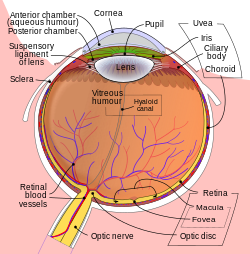| Eye | |
|---|---|
 | |
| Schematic diagram of the vertebrate eye. | |
 | |
| Compound eye of Antarctic krill |
Eyes are organs that detect light, and send signals along the optic nerve to the visual and other areas of thebrain[citation needed]. Complex optical systems with resolving power have come in ten fundamentally different forms, and 96% of animal species possess a complex optical system.[1] Image-resolving eyes are present in cnidaria,molluscs, chordates, annelids and arthropods.[2]
The simplest "eyes", such as those in unicellular organisms, do nothing but detect whether the surroundings are light or dark, which is sufficient for the entrainment of circadian rhythms. From more complex eyes, retinal photosensitive ganglion cells send signals along the retinohypothalamic tract to the suprachiasmatic nuclei to effect circadian adjustment.




No comments:
Post a Comment